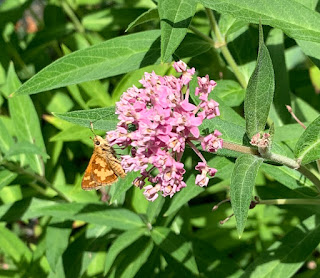Gardeners tend to categorize insects as leaf-eaters, beneficials, or pollinators. I used to regard leaf-eaters as a scourge. I’ve changed my attitude now that I understand their importance at the base of the food web, just one level up from plants.
 |
| Leaf-eaters provide important ecosystem services |
Plants convert the sun’s energy into carbohydrates through photosynthesis. Leaf-eating insects pass that energy on up the chain. So when I see my kohlrabi’s chewed leaves, I try to remember that the larvae of the cabbage white butterfly (Pieris rapae) that did the damage also provided food for birds and other animals that I want around.
 |
| Cabbage white larvae found the kohlrabi |
Beneficial insects are the carnivores that eat leaf-eaters and keep their populations in balance. Some of my favorites are damselflies and dragonflies (Odonata). These are top predators of the insect world, capable of grabbing their prey on the wing because they have the ability, unique among insects, to fly in all directions.
 |
| Virtuoso flyers of the insect world |
Many of the insects I thought were dragonflies are really damselflies, close relatives. At rest, damselflies hold their wings along their bodies, whereas dragonfly wings are held perpendicularly. I’m delighted to notice so many of these beneficial insects around the garden. I’m rarely quick enough to snap their photos, but I relish their bright colors, especially the blues and reds. They often perch on fence posts or flower stalks, like hawks surveying their domain for prey. Damselflies particularly like to eat mosquitoes, so they’re doubly welcome.
 |
| Blue damselfly-photo NPS |
I’m hoping that our small garden pond is providing good habitat for dragonfly and damselfly nymphs, the developmental stage before the flying adults. The nymphs live in water for months before emerging on shore, breaking open their exoskeletons, and flying away. I want to witness that someday.
Among pollinators, we’re thrilled to have been adopted by a ruby-throated hummingbird (Archilochus colubris) that feeds on the nectar of trumpet-shaped flowers near the house: trumpet honeysuckle (Lonicera sempervirens) and hummingbird sage (Salvia guaranitica). Hummingbirds are territorial; males will fight to defend their territory. This one seems to have claimed our deck for his own, and I wish him many happy returns from the migration to his winter home in Central America.
 |
| Hummingbird feeding on cardinal flower |
Then there are the butterflies. This week I saw more kinds than ever before. Several monarchs (Danaus plexippus) happened by, checking out the swamp milkweed (Asclepias incarnata).
 |
| Swamp milkweed offers a host for monarch larvae |
I’m pretty sure I saw a spicebush swallowtail (Papilio troilus), maybe attracted to a new spicebush (Lindera benzoin) that I planted last year. An American lady (Vanessa virginiensis) alighted on a goldenrod whose flowers are just opening. An Eastern tiger swallowtail (Papilio glaucus) wafted high up among the trees.
 |
| Spicebush swallowtail-photo Katja Schulz |
I’m increasing my offerings of larval host plants for these butterfly species and also multiplying their nectar sources, the native flowering plants that the adults go to for food. Goldenrods, asters, black-eyed Susans, milkweeds, sunflowers—it’s a banquet for nectaring butterflies.
 |
| A Long Dash butterfly? also on swamp milkweed |
No comments:
Post a Comment